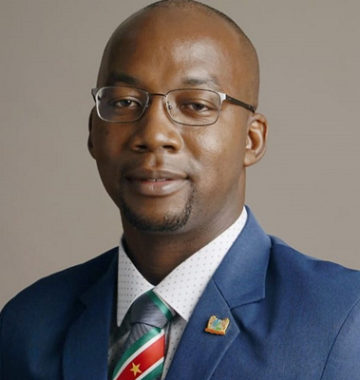Capital: Paramaribo
Official Language: Dutch
Status: Independent Republic 25 November 1975
Area: 163,820 sq Km, 63,251 sq Mi
Population: 531,170 (2010)
Currency: Surinamese dollar (SRD)
Motto: Justice, Compassion, Loyalty
Beating Hearth of the Amazone
Suriname (or Surinam), officially known as the Republic of Suriname, is a country in northern South America. It is bordered by French Guiana to the east, Guyana to the west, Brazil to the south and the Atlantic Ocean to the north. Suriname, the Netherlands Antilles (until its dissolution in 2010) and the Netherlands itself have cooperated on a basis of equality since 1954. It is also a member of CARICOM and is considered as a Caribbean country that is not an island. At just under 165,000 km, Suriname is the smallest sovereign state in South America.

Minister of Natural Resources
Mr. Dr. J.C. de Mirandastraat 13-15, Paramaribo
Tel: 597 474 666
Email: secretariat.nh @gov.sr / voorl.minnh.bron @gmail.com
Permanent Secretary, Ministry of Natural Resources
secretariaat.nh@gov.sr
Suriname is situated in the northeast coast of South America; it is bounded by the Atlantic Ocean on the north, Guyana on the west, French Guiana to the east and Brazil to the South.
Amerindians inhabited the country up to the 15th century. Settlers came from England, The Netherlands, France, and Germany, among others. Africans were brought as slaves, and indentured labourers from India, Indonesia, and China were brought to Suriname during the 18th century. Struggle for possession by the French, British and Dutch ended with control by the Netherlands in 1815. Slavery was abolished in 1863. The country gained independence in 1975. In February 1980, a military coup brought Commander Desi Bouterse into Office. In 1987, national elections were held and democracy was restored. In October 1997, an attempt to overthrow the government was foiled.
Agriculture is an important economic sector for Suriname. The main crops are rice, fruit (including bananas) and vegetables. Rice accounts for approximately half of total cultivated land. The export of shrimp and scale fish also contribute to Suriname’s foreign exchange earning. There is a small fish farming sector producing fish, shrimp and crab meat, mainly for domestic consumption.
The timber industry is a growth sector, supported by the abundance of tropical forestry resources.
Suriname is the eighth largest bauxite producer. Alumina and aluminium are crucial to the economy, accounting for more than two-thirds of exports earnings. Gold mining is a growth area despite suffering severely from weak world prices in the late 1990s.
The manufacturing sector continues to hold its own. This sector includes aluminium production, import-substituting industries using local and importing inputs, and processing of local agricultural products. Food processing is about 60% of manufacturing activities.
Tourism is a prime potential growth sector. The interior rainforest and coastal wetlands augur well for a vibrant eco-tourism industry.
Johan Adolf Pengel International
Zanderij
Commercial: 7:30 a.m. to 4:30 p.m. Monday to Friday. 7:30 a.m. to 12:30 p.m. on Saturday.
Government: 7:00 a.m. to 3:00p.m., Monday to Thursday, 7:00 a.m. to 2:30 p.m. on Friday.
New Year’s Day, January 1; Eid –Ul-Fitr (as decreed); Phagwah (as decreed) Good Friday; Easter Monday; Labour Day, May 1; Keti-Koti / Emancipation Day, July 1; Independence Day, November 25; Republic Day, September 24; Christmas Day, December 25; Boxing Day, December 26. Holidays that fall on a Sunday are not automatically observed the Monday following; however, holiday sometimes given at the President’s discretion.
4 July, 1995
Green – Fertility of the Nation, hopeful expectation, the new Suriname
White – Justice and liberty
Red – Love which urges the nation to action, progressiveness
Yellow – Sacrifice
Yellow Star – Sacrifice in unity and orientation on the golden future